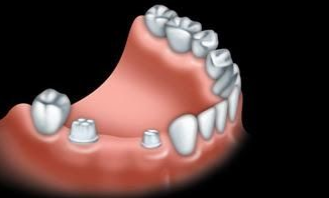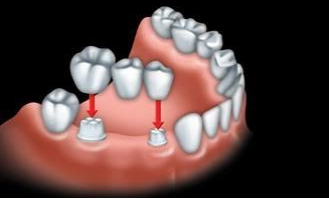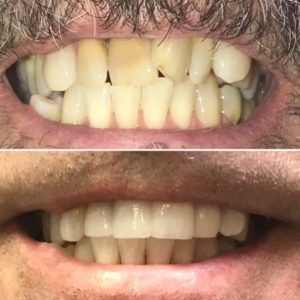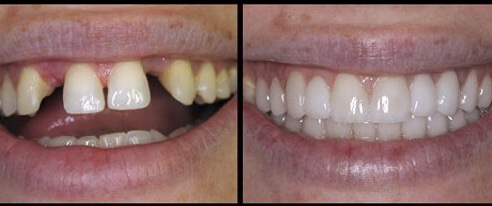Crown and Bridge
If your tooth is damaged but not lost, a crown can be used to restore its shape, appearance, and function. You may need a crown if you have a root canal, a large filling in a tooth or a broken tooth.
A crown also called a cap, is a hollow, artificial tooth used to cover a damaged or decayed tooth. The crown restores the tooth and protects it from further damage. Crowns can also be used to cover a discoloured or misshapen tooth. A tooth that has been fixed with a crown looks and works very much like a natural tooth.
Who does this procedure?
If you need to have a tooth crowned, your dentist may do it, or he or she may refer you to a prosthodontist. A prosthodontist is a dentist who has completed a university post-graduate specialty program in prosthodontics. Prosthodontics is a specialty of dentistry that deals with restoring and replacing natural teeth and tissues with artificial substitutes.
How a crown is done
- Your dentist gives you a local anesthetic.
- To make room for the crown, your dentist files down the tooth that needs to be restored.
- An impression of the filed-down tooth and nearby teeth is taken. This impression is used to custom make your final crown. The crown is built using restorative material (a material
used for fillings) based on the impression. The final crown will be the right shape for your mouth. - Until your final crown is ready, your dentist places a temporary crown over the tooth that
needs to be restored. The temporary crown is made from an impression of your tooth before it was filed down. It protects your tooth until the final crown is ready. A temporary crown may not have the same shape and color as a final crown. - On your next visit, your dentist takes off the temporary crown and puts on the final one. Your dentist checks to make sure the crown is the right fit, shape, color and bite. If it is, your dentist cements the crown into place.
These are the steps dentists most often follow in making a crown, but your tooth may need special care. You may need orthodontic treatment, gum treatment or root canal treatment. It may take more than 2 visits to your dentist, or your visits may last longer.

Different types of crowns
Crowns are made from various types of materials. Depending on which tooth needs a crown, your dentist will suggest a material, or combination of materials, that is right for you
Ceramic crowns look the most natural. They are currently the most common type of crown material used today. With proper care, they can last 15 years or more.
Metal crowns are made of gold. They generally last a long time and won’t chip or break. They tend not to wear down your opposing natural teeth. However, the gold color does not look natural, particularly on front teeth.
What else should I know?
Crowns are strong and generally last for about 15 years or longer if you take good care of them. Brush and floss your crown, just like you clean your natural teeth. Crowns may not be as strong as your natural teeth. So like your natural teeth, remember not to bite down on hard objects or
use your teeth to open or cut things.
Bridge
A bridge also called a “fixed bridge” or a “fixed dental prosthesis,” is a dental restoration that replaces one or more missing teeth. It extends across an area that has no teeth and is typically made up of an artificial tooth fused between 2 crowns. (A crown is a hollow, artificial tooth that fits over a natural tooth or a dental implant). The bridge is held firmly in place by your own teeth on each side of the missing one(s) or by dental implants. A bridge is permanent and cannot be removed.
How a bridge is done
- If you have healthy teeth on each side of a missing tooth (or teeth), your dentist files down the 2 healthy teeth to prepare them for the bridge. If you don’t have healthy teeth or enough teeth to support a bridge, then dental implants may be surgically placed. A dental implant is an artificial root made of titanium metal that is inserted into the jawbone to replace the root of the natural tooth. The implant acts as an anchor to hold an artificial tooth or bridge in place.
- Next, your dentist makes a model of your teeth by taking impressions (molds). The model is used to custom-make the artificial tooth (or teeth) and 2 crowns as one piece. This piece is called a bridge.
- Meanwhile, your dentist places a temporary bridge in your mouth to protect the exposed teeth and gums.
- During your second visit, your dentist removes the temporary bridge and places the custom made bridge in your mouth. The crowns are either cemented to your 2 healthy teeth or attached to your dental implants on each side of the missing tooth (or teeth).
Types of bridges
There are different types of dental bridges. Your dentist will recommend the most appropriate one depending on the location of the missing tooth (or teeth) and the condition of your teeth, mouth, and gums. Traditional bridges are used if there are natural teeth on each side of the gap where the tooth is missing. (As an alternative to a bridge, your dentist may suggest a single implant to replace a missing tooth between 2 healthy teeth. An implant will prevent you from having to get your healthy teeth filed down in preparation for the crowns.)



Implant bridges are used if you don’t have healthy teeth or enough teeth to support a bridge, or when several or all teeth are missing. A custom-made bridge is anchored to the dental implants. Your dentist will first determine if dental implants are right for you.



Resin-bonded bridges, also known as “Maryland” bridges, are used when the missing teeth are in the front of the mouth. This type of bridge involves the artificial teeth being fused together to metal bands and cemented to the back of your natural teeth.
Cantilever bridges are used when there are healthy teeth on only one side of the missing tooth or teeth. This procedure involves anchoring the artificial tooth over one or more of your natural adjacent teeth
Caring for your bridge
If you take good care of your bridge, it should generally last for about 10 years, or perhaps longer. Like natural teeth, bridges need to be brushed and flossed every day. Your dentist will show you how to use a floss threader to floss under and around the artificial tooth (or teeth) in the middle of the bridge. After flossing, roll it up in a tiny ball and put it in the garbage. Never flush floss down the toilet. Regular dental visits and professional cleanings are also important. If you have an implant bridge, your dentist will show you how to properly care for them.



